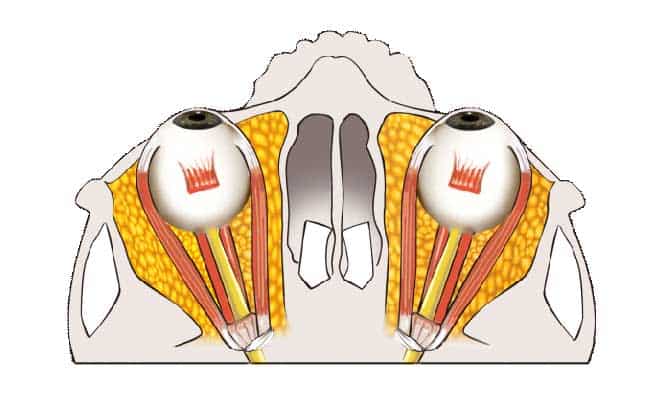Orbit
The following are some of the conditions of the orbit .
Thyroid dysfunction is a commonly encountered condition which can affect the eyes ranging from bulging of eyes and retraction of the lids, leading to facial asymmetry to sight threatening complication. Both medical and surgical modalities of treatment are available for this condition, by your Ophthalmic Plastic surgeon.
A fracture in the bones around the eye can cause double vision, and a sunken small appearance of the eye. The fracture is repaired with an implant or plate.
Oculoplasty

Facilities and procedures available
Orbitotomy surgery for orbital tumors
See section on ocular oncology
Book an appointment with our Oculoplasty Team
Orbital fracture repair
An orbital fracture is a fracture, or break, in the bones around the eye. It can cause swelling, or can cause the eyeball to look small and sunken backwards.
Sometimes the muscles around the eye can get caught and stuck in the broken bone. The eye cannot move freely, and the patient starts to see double. Especially in young patients, an eye muscle stuck in a broken bone can lead to giddiness and vomiting. If the broken bone presses on the nerve under the eye (the infra-orbital nerve), the patient loses sensation on that side of the cheek.

Book an appointment with our Oculoplasty Team
Thyroid eye disease/ Surgery for bulging eyes – Orbital decompression
Thyroid eye disease (TED) is a disease marked by swelling of muscles and fatty tissues surrounding the eyeball within the eye socket. It is also known by other names such as Thyroid related ophthalmopathy(TRO), Dysthyroid eye disease, Grave’s Ophthalmopathy or Ophthalmic Grave’s disease.
The swelling of the muscles and soft tissue pushes the eyeball forward, causes double vision. In severe cases, there is loss of vision due to compression of the nerve connecting the eye to the brain. When the eye is pushed forward the clear window of the eye(cornea) loses its protection provided by the eyelids and may get damaged.

Call us to Book an Appointment
Evisceration and implant
Some patients develop a disfigured and/or painful blind eye due to disease or injury. There is no hope of regaining vision in the eye. We can however, help the patient to achieve comfort in that eye, and a near natural appearance.
Book an appointment with our Oculoplasty Team
Socket reconstruction
After the loss of an eye the space available in the socket may shrink, and this is called a ‘contracted socket’. The shrinking of the space makes it difficult to wear any prosthesis. The artificial eye may appear deformed, or fall off repeatedly. It may also appear small and sunken. Socket reconstruction is the surgery by which we create space and shape in the socket, so that a good prosthesis can be fitted.
Space to fit a prosthesis can be created deep in the upper and lower edge (fornix deepening). We may need to graft tissue from inside the mouth (mucous membrane graft). Occasionally, we will need to fill up the hollow; this can be done by placing an orbital implant. Another option is to take some tissue from the patient’s hip and place it in the socket (dermis fat graft). The socket accepts its own body tissue very well.

Call us to Book an Appointment
FAQ
Frequently Asked Questions
WHO REPAIRS AN ORBITAL FRACTURE?
Any injury around the eye should combine the expertise of an eye surgeon during treatment; the first chance is the best chance of having a good result. The orbit and oculoplasty surgeon can repair an orbital fracture. The advantage is that the double vision and other visual problems can the treated at the same time as the repair.
In some patients, the fracture extends to the cheek bone. In such a situation, a maxillofacial surgeon can do combined surgery along with the oculoplastic surgeon.
WHAT IS DONE IN AN ORBITAL FRACTURE REPAIR?
The muscle which was stuck to the broken bone is gently released and returned back to its normal position. The gap in the bone is bridged with an implant. At Narayana Nethralaya, your surgeons may choose a titanium plate to close the gaps or they may choose to use a porous polyethylene sheet – this is a material where the orbital tissues can grow into, and it becomes integrated into the orbit.
WHAT IS THE CORRECT TIME FOR REPAIR?
For fractures which are causing giddiness and vomiting, the repair needs to be done as soon as possible. For other fractures, your surgeon may choose to wait 1 to 2 weeks to let the swelling improve, so that the outcome is better. Excessive delay in surgery leads to a worse outcome.
WILL THE SURGERY LEAVE A SCAR?
The surgery is performed through a transconjunctival (hidden) route, and will leave no visible scar.
WHO GETS THYROID EYE DISEASE?
It is a rare condition affecting women more than men. Most of these people have a problem with an overactive thyroid gland and have an underlying autoimmune condition. It can also occur in people with normal or low thyroid hormone levels. It generally occurs in middle age. It is also more likely to develop if you smoke.
WHAT ARE THE SYMPTOMS OF TED?
- Redness, irritation of eyes as the sensitive cornea is less well covered or lubricated by the eyelids. In severe cases, it can lead to damage of the cornea, causing loss of vision.
- Eye pain
- Bulgy looking eyes giving a staring appearance
- Double vision (diplopia) as the muscles become too swollen to work properly
- Blurring of vision in advances cases
- Difficulty in differentiating colours
HOW IS TED DIAGNOSED?
Diagnosis can be made by eye examination if you already have a diagnosis of a thyroid gland problem
- Blood tests are done to know the status of thyroid hormones
- Scans –A CT /MRI scan of the eye socket (orbit) is done to know the status of the eye muscles and the swelling of eye nerve.
- Other tests – In some cases, other tests like visual fields, colour vision test are done to know the extent of the eye nerve compression due to the swelling. A ‘Diplopia charting’ and ‘Hess charting’ are performed to measure double vision.
WHAT IS THE TREATMENT OF THYROID EYE DISEASE?
The treatment of TED depends on the stage of the disease.
Medical– In the early stages of the disease and where the disease stays mild, artificial tears(lubricants) may be sufficient. If you have very severe disease and vision is a matter of concern as a result of the disease, you may need steroids.As the disease progresses, you may need immunosuppressive drugs – a family of medicines that dampens down the immune system which is producing abnormal antibodies responsible for TED. For Double vision(diplopia), modified glasses or prism glasses can be prescribed.
Surgical– Immediate surgery may be required in severe cases with compression of eye nerve. Once the eye disease has reached a quiet stage, surgery can be done to make the eyes look normal . This is called a ‘reconstruction’, that is putting the structures back in their proper places. Orbital decompression is done to make the eyes look less prominent.
Surgical correction of the eyelid can also be contemplated to improve the appearance. Squint and double vision can be corrected surgically once the disease has reached inactive phase.
ARE STEROIDS NECESSARY? I HAVE HEARD THAT THEY ARE HARMFUL.
Steroids are prescribed in TED only when necessary. Your oculoplastic surgeon assesses your eye to see how ‘active’ your disease is. If the activity is high, steroids are required, particularly for serious disease which can cause trouble for your vision, steroids are the best option.
The preferred choice of steroid in TED is intravenous, that is, injections of methyl prednisolone. Intravenous methylprednisolone is more effective, and with fewer side effects than steroid tablets. It is always given in conjunction with your physician or endocrinologist, who will watch out for any side effects.
WHAT IS ORBITAL DECOMPRESSION?
In TED, the structures behind the eye (in the orbit) are thickened, packed tightly together, and pushing the eyeball out. Orbital decompression creates more space behind the eye. Extra fat which grew due to TED is removed. Part of the bony box behind the eye (the orbit) is drilled to make more space for the vital structures, and to allow the eyeball to move back in.
IS THERE ANYTHING THE PATIENT CAN DO?
Yes. Here are a few tips.
- Stop Smoking
- Sleeping propped up will help reduce the puffiness around the eyes
- A cold compress around the eye helps to reduce puffiness
- Keep a good control on your thyroid levels and follow the advice of your endocrinologist.
- Check your Vitamin D levels
- Some food supplements containing selenium may be helpful.
Sunglasses can help as many patients find bright light uncomfortable
What is a good age to start progressive socket expansion?
We prefer to start the procedure at a few months of age for the child. In an older child, as some growth has already made the other socket larger; it will take longer to catch up to that growth. However, a new born, a few days or a few weeks old may need care for other issues. So a good compromise is when the child is a few months old, healthy and growing, but not too old.
IS THE WHOLE EYE REMOVED IN EVISCERATION?
Only the damaged portions of the eyeball are removed during the surgery of evisceration. The outer sclera (white shell of the eye) is still left intact. The eye muscles are also left intact, so that some eye movement remains.
After removal of the damaged cornea and retina, a ball implant is placed within the sclera. This fills up the hollow and prevents a sunken appearance.
WHAT ARE THE DIFFERENT IMPLANTS AVAILABLE?
The common implants used are Polymethyl methacrylate and silicone. They are inert materials and are tolerated well by human socket tissues. Porous polyethylene or bioceramic implants have numerous tiny pores; the socket tissues grow into these pores and they become integrated.
HOW LONG DOES THE ENTIRE PROCESS TAKE?
It takes about 6 weeks for the socket to heal completely. Thereafter, a custom made ocular prosthesis can be fitted.
Our patient care philosophy
At Narayana Nethralaya, “Quality of Care” and “Patient Safety” is our priority. Concern for our patients’ well being is at the core of what we do, and what drives us. All 4 units of Narayana Nethralaya are NABH Accredited – the highest national recognition for quality in patient care and safety. Our Oculoplasty team help patients make an informed treatment choice on the type of treatment and surgery that is best suited for their lifestyle. We have an exclusive counseling team to address any doubts or questions that people may have about Oculoplasty treatment options and procedures.

